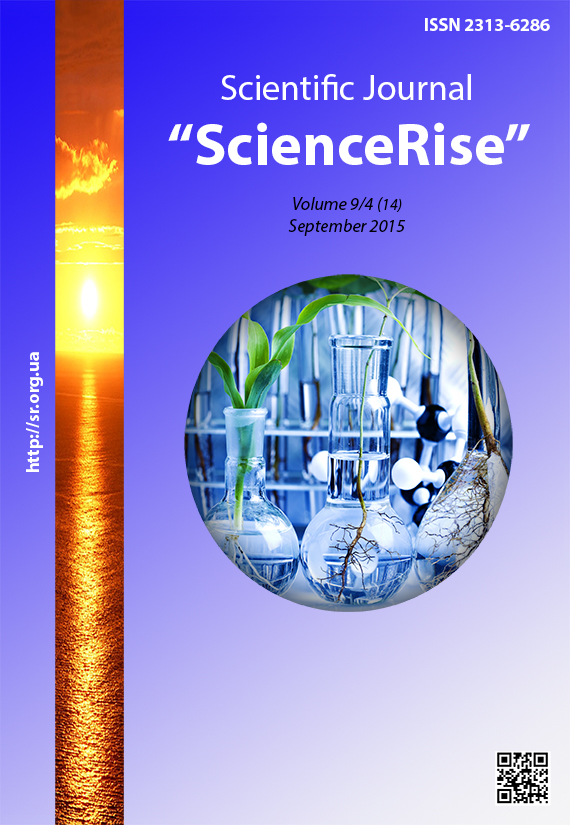Clinical and experimental substantiation of the method the biliary debit manometry
DOI:
https://doi.org/10.15587/2313-8416.2015.50323Keywords:
biliary debit manometry, experimental substantiation, modelingAbstract
Introduction. In spite of the permanent improvement of the diagnostic methods of causes of biliary obstruction it has not 100 % sensitivity and specificity and received data can be erroneous and difficult for clinical interpretation.
Substantiation. To assess at the modern scientific and technical level the functional state of patency of terminal section of choledoch using modified method of debit manometry that consists in registration of the volume of liquid injected into bile-excreting and the pressure in it.
Materials and methods of research. At elaboration of methods at the first stage it was carried out numerical modeling on the base of physical model of bile-excreting system with assessment of the levels of pressure in bile-excreting ducts at liquid injection, assessment of form of the curve of pressure changes and factors that influence on form and parameters of curve. At the second stage it was carried out an experimental assessment of correspondence of these models to the real data received in department of morbid anatomy. And at the last clinical stage it was carried out diagnostics of disorders of patency of bile-excreting system with following assessment of diagnostic and practical value of this method.
Results. The data received in experiment and modeling allowed to interpret the results of debit manometry received at examination of patients on the next algorithm: at the first stage it was assessed the type of curve: bell-shaped – disorder of outflow is absent but at the fast evacuation the disorders of consistency of sphincteral apparatus cannot be excluded, tooth-shaped – indicates the disorder of outflow of bile what can be caused by both organic and functional reasons, horizontal type – indicates the strict obstruction usually of organic character. At the second one it were assessed the quantitative indicators, the high level of pressure at the bolus introduction testified to the bile-excreting ways (BEW) obstruction, the low one – to an inconsistency of sphincteral apparatus.
Conclusions. The numerical experimental data allowed establish regularities of bile-excreting system functioning from the positions of hydrodynamics. Verification of these data in conditions of controlled experiment on the real bile-excreting ducts allowed confirm these conclusions and specify the features of hemodynamics in conditions of dissected sphincteral apparatus
References
Galperin, E. I., Vetshev, P. S. (2009). Rukovodstvo po chirurgii schelchnich putey [Guidelines for surgery of the biliary tract]. Moscow: Publishing house Vidar-M, 568.
Sazhyn, V. P., Fedorov, A. V., Sazhyn, A. V. (2010). Endoskopicheskaya Chirurgiya [Endoscopic surgery]. Moscow: GEOTAR Media, 214–255.
Shalymov, A. A., Shalymov, S. A., Nychytajlo, M. E., Domanskyj, B. V. (1993). Chirurgia pecheni i shelchivuvodaychich putey [Surgery of liver and biliary tract]. Kyiv: Health Protection, 512.
Dasari, B. V., Tan, C. J., Gurusamy, K. S. et. al (2013). Surgical versus endoscopic treatment of bile duct stones. Cochrane Database Syst. Rev., 9, CD003327.
ElGeidie, A. A. (2014). Single-session minimally invasive management of common bile duct stones. World Journal of Gastroenterology, 20 (41), 15144–15152. doi: 10.3748/wjg.v20.i41.15144
Gurusamy, K. S., Giljaca, V., Takwoingi, Y. et. al (2015). Endoscopic retrograde cholangiopancreatography versus intraoperative cholangiography for diagnosis of common bile duct stones. Cochrane Database Syst. Rev., 2, CD010339.
Ledro-Cano, D. (2007). Suspected choledocholithiasis: endoscopic ultrasound or magnetic resonance cholangio-pancreatography? A systematic review. European Journal of Gastroenterology & Hepatology, 19 (11), 1007–1011. doi: 10.1097/meg.0b013e328133f30b
Kenny, R., Richardson, J., McGlone, E. R., Reddy, M., & Khan, O. A. (2014). Laparoscopic common bile duct exploration versus pre or post-operative ERCP for common bile duct stones in patients undergoing cholecystectomy: Is there any difference? International Journal of Surgery, 12 (9), 989–993. doi: 10.1016/j.ijsu.2014.06.013
Lu, J., Cheng, Y., Xiong, X.-Z., Lin, Y.-X., Wu, S.-J., Cheng, N.-S. (2012). Two-stage vs single-stage management for concomitant gallstones and common bile duct stones. World Journal of Gastroenterology, 18 (24), 3156. doi: 10.3748/wjg.v18.i24.3156
Wong, H.-P., Chiu, Y.-L., Shiu, B.-H., Ho, L.-C. (2011). Preoperative MRCP to detect choledocholithiasis in acute calculous cholecystitis. Journal of Hepato-Biliary-Pancreatic Sciences, 19 (4), 458–464. doi: 10.1007/s00534-011-0456-8
Downloads
Published
Issue
Section
License
Copyright (c) 2015 Александр Викторович Горбулич, Николай Николаевич Велигоцкий, Николай Николаевич Скалий, Сергей Эдуардович Арутюнов, Станислав Артурович Павличенко, Александр Александрович Лермонтов

This work is licensed under a Creative Commons Attribution 4.0 International License.
Our journal abides by the Creative Commons CC BY copyright rights and permissions for open access journals.
Authors, who are published in this journal, agree to the following conditions:
1. The authors reserve the right to authorship of the work and pass the first publication right of this work to the journal under the terms of a Creative Commons CC BY, which allows others to freely distribute the published research with the obligatory reference to the authors of the original work and the first publication of the work in this journal.
2. The authors have the right to conclude separate supplement agreements that relate to non-exclusive work distribution in the form in which it has been published by the journal (for example, to upload the work to the online storage of the journal or publish it as part of a monograph), provided that the reference to the first publication of the work in this journal is included.

